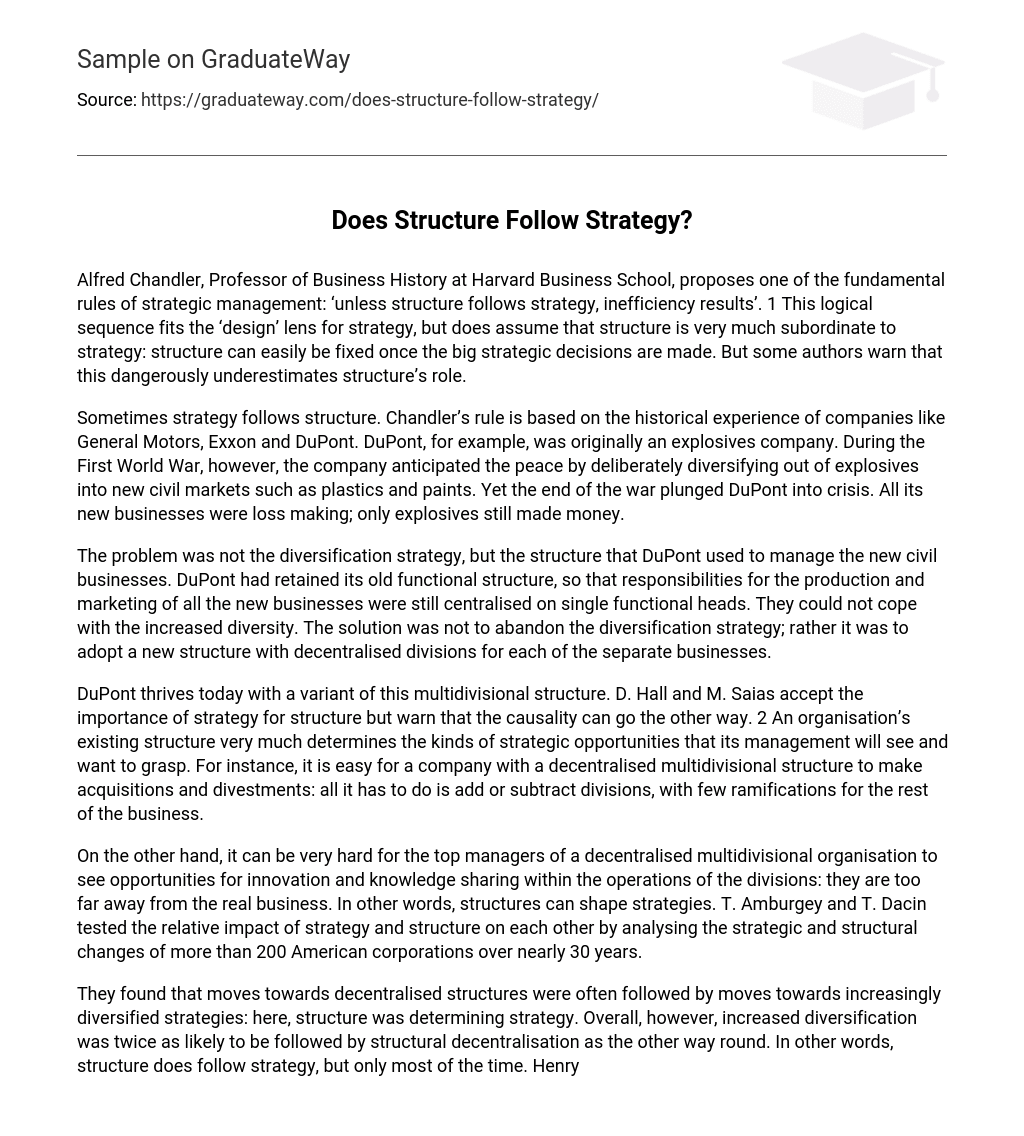Alfred Chandler, Professor of Business History at Harvard Business School, proposes one of the fundamental rules of strategic management: ‘unless structure follows strategy, inefficiency results’. 1 This logical sequence fits the ‘design’ lens for strategy, but does assume that structure is very much subordinate to strategy: structure can easily be fixed once the big strategic decisions are made. But some authors warn that this dangerously underestimates structure’s role.
Sometimes strategy follows structure. Chandler’s rule is based on the historical experience of companies like General Motors, Exxon and DuPont. DuPont, for example, was originally an explosives company. During the First World War, however, the company anticipated the peace by deliberately diversifying out of explosives into new civil markets such as plastics and paints. Yet the end of the war plunged DuPont into crisis. All its new businesses were loss making; only explosives still made money.
The problem was not the diversification strategy, but the structure that DuPont used to manage the new civil businesses. DuPont had retained its old functional structure, so that responsibilities for the production and marketing of all the new businesses were still centralised on single functional heads. They could not cope with the increased diversity. The solution was not to abandon the diversification strategy; rather it was to adopt a new structure with decentralised divisions for each of the separate businesses.
DuPont thrives today with a variant of this multidivisional structure. D. Hall and M. Saias accept the importance of strategy for structure but warn that the causality can go the other way. 2 An organisation’s existing structure very much determines the kinds of strategic opportunities that its management will see and want to grasp. For instance, it is easy for a company with a decentralised multidivisional structure to make acquisitions and divestments: all it has to do is add or subtract divisions, with few ramifications for the rest of the business.
On the other hand, it can be very hard for the top managers of a decentralised multidivisional organisation to see opportunities for innovation and knowledge sharing within the operations of the divisions: they are too far away from the real business. In other words, structures can shape strategies. T. Amburgey and T. Dacin tested the relative impact of strategy and structure on each other by analysing the strategic and structural changes of more than 200 American corporations over nearly 30 years.
They found that moves towards decentralised structures were often followed by moves towards increasingly diversified strategies: here, structure was determining strategy. Overall, however, increased diversification was twice as likely to be followed by structural decentralisation as the other way round. In other words, structure does follow strategy, but only most of the time. Henry Mintzberg concludes that ‘structure follows strategy as the left foot follows the right’. 4 In other words, strategy and structure are related reciprocally rather than just one way.
Mintzberg warns that a simple ‘design’ approach to strategy and structure can be misleading. Structure is not always easy to fix after the big strategic decisions have been made. Strategists should check to see that their existing structures are not constraining the kinds of strategies that they consider. Notes 1. A. Chandler, Strategy and Structure: Chapters in the History of American Enterprise, MIT Press, 1962, p. 314. 2. D. J. Hall and M. A. Saias, ‘Strategy follows structure! ’, Strategic Management Journal, vol. 1, no. 2 (1980), pp. 149–163. 3. T. Amburgey and T.
Dacin, ‘As the left foot follows the right? The dynamics of strategic and structural change’, Academy of Management Journal, vol. 37, no. 6 (1994), pp. 1427–1452. 4. H. Mintzberg, ‘The Design School: reconsidering the basic premises of strategic management’, Strategic Management Journal, vol. 11 (1990), pp. 171–195. Question Hall and Saias suggest that organisational structures can influence the kinds of strategies that management teams will pursue. What kinds of organisations might be particularly susceptible to structural constraints on their strategies?





